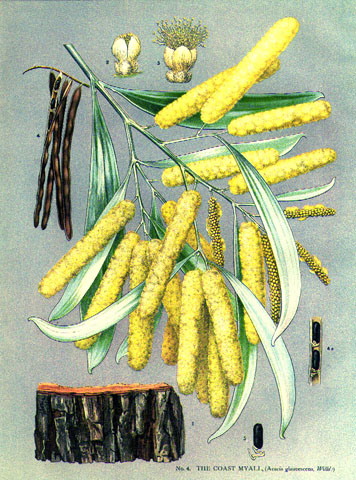Classification System: APG IV
Superregnum: Eukaryota
Regnum: Plantae
Cladus: Angiosperms
Cladus: Eudicots
Cladus: Core eudicots
Cladus: Rosids
Cladus: Eurosids I
Ordo: Fabales
Familia: Fabaceae
Subfamilia: Caesalpinioideae
Tribus: Acacieae
Genus: Acacia
Species: Acacia binervia
Name
Acacia binervia (J.C.Wendl.) J.F.Macbr., 1919
Synonyms
Acacia cinerascens Sieber ex DC.
Acacia glaucescens Willd.
Acacia homomalla H.L.Wendl.
Mimosa binervia J.C.Wendl.
Mimosa glaucescens Poir.
Racosperma binervium (J.C.Wendl.) Pedley
Distribution
Native distribution areas:
Acacia binervia
Continental: Australasia
Regional: Australia
New South Wales, Victoria
Introduced into:
Kenya
References: Brummitt, R.K. 2001. TDWG – World Geographical Scheme for Recording Plant Distributions, 2nd Edition
References
Primary references
Macbride, J.F., 1919. Contributions from the Gray Herbarium of Harvard University. Cambridge, MA 59:7.
Links
Govaerts, R. et al. 2020. Acacia binervia in Kew Science Plants of the World online. The Board of Trustees of the Royal Botanic Gardens, Kew. Published on the internet. Accessed: 2020 Jul 26. Reference page.
International Plant Names Index. 2019. Acacia binervia. Published online. Accessed: Jul 26 2019.
Tropicos.org 2019. Acacia binervia. Missouri Botanical Garden. Published on the internet. Accessed: 2019 Jul 26.
Hassler, M. Jul. Acacia binervia. World Plants: Synonymic Checklists of the Vascular Plants of the World In: Roskovh, Y., Abucay, L., Orrell, T., Nicolson, D., Bailly, N., Kirk, P., Bourgoin, T., DeWalt, R.E., Decock, W., De Wever, A., Nieukerken, E. van, Zarucchi, J. & Penev, L., eds. Jul. Species 2000 & ITIS Catalogue of Life. Published on the internet. Accessed: Jul 26 {{{3}}}. Reference page.
USDA, ARS, Germplasm Resources Information Network. Acacia binervia in the Germplasm Resources Information Network (GRIN), U.S. Department of Agriculture Agricultural Research Service. Accessed: 09-Oct-10.
Vernacular names
English: Coast Myall
Acacia binervia, commonly known as the coast myall, is a wattle native to New South Wales and Victoria. It can grow as a shrub or as a tree reaching 16 m in height.[1] This plant is reportedly toxic to livestock as the foliage (phyllodes) contain a glucoside which can produce hydrogen cyanide if cut.[1]
Taxonomy
German botanist Johann Christoph Wendland first described this species as Mimosa binervia in 1798,[2] before American botanist James Francis Macbride reclassified it in the genus Acacia in 1919.[3] Common names include coast myall and rosewood.[3] Acacia glaucescens is an illegitimate name.[4]
Description
Acacia binervia grows as a shrub to small tree anywhere from 2 to 16 m (6.6 to 52.5 ft) high. The bark is dark brown to grey in colour, and the elliptic to sickle-shaped (falcate) phyllodes are 6–15 cm (2.4–5.9 in) in length and 0.5–2.3 cm (0.20–0.91 in) wide. The cylindrical yellow flowers appear in spring (August to October).[1] Flowering is followed by the development of 6–8 cm long seed pods, which are ripe by December.[5]
Distribution and habitat
Acacia binervia is found in central New South Wales from the Hunter Region south, and to Bungonia in the southwest, and continuing south into Victoria.[1] In the Sydney basin, it grows on a variety of soils and associated plant communities—alluvial soils, sandstone-, shale- or trachyte-based soils, generally with good drainage. It grows in dry sclerophyll forest, associated with such species as yellow bloodwood (Corymbia eximia), grey gum (Eucalyptus punctata), narrow-leaved ironbark (E. crebra), mugga ironbark (E. sideroxylon), or more open woodland with narrow-leaved ironbark and black cypress pine (Callitris endlicheri), and riparian (riverbank) forest with river peppermint (E. elata) and gossamer wattle (Acacia floribunda).[5]
Ecology
Acacia binervia regenerates from bushfire by a soil-borne seedbank, the seeds germinate and grow after fire while adult plants are killed. The frequency of fire for the cycle to persist is anywhere from 10 to 50 years.[5] It is useful to bees in the honey industry.[5]
References
Wikispecies has information related to Acacia binervia.
P.G. Kodela. "New South Wales Flora Online: Acacia binervia". Royal Botanic Gardens & Domain Trust, Sydney, Australia.
"Mimosa binervia J.C.Wendl". Australian Plant Name Index (APNI), IBIS database. Centre for Plant Biodiversity Research, Australian Government.
"Acacia binervia (J.C.Wendl.) J.F.Macbr". Australian Plant Name Index (APNI), IBIS database. Centre for Plant Biodiversity Research, Australian Government.
"Acacia glaucescens Willd. [nom. illeg. ]". Australian Plant Name Index (APNI), IBIS database. Centre for Plant Biodiversity Research, Australian Government.
Benson, Doug; McDougall, Lyn (1996). "Ecology of Sydney Plant Species Part 4: Dicotyledon family Fabaceae" (PDF). Cunninghamia. 4 (4): 552–752. ISSN 0727-9620. Archived from the original (PDF) on 2014-06-23. Retrieved 2011-11-01.
Retrieved from "http://en.wikipedia.org/"
All text is available under the terms of the GNU Free Documentation License


